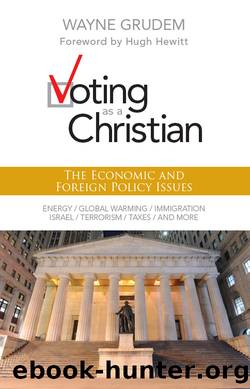Voting as a Christian by Wayne A. Grudem

Author:Wayne A. Grudem [Grudem, Wayne]
Language: eng
Format: epub
ISBN: 978-0-310-49603-8
Publisher: Zondervan
Published: 2001-01-15T00:00:00+00:00
Lawrence Solomon, in The Deniers, had already written that the Climategate scandal made the historical temperature data suspect and that carbon dioxideâs âcontribution to global warming remains approximately nil.â55 The broader implications of Climategate and related datamanipulation scandals were still unfolding at the time of this writing.
d. Are glaciers melting and sea levels rising?
For years now, the public has been bombarded with messages that man-made global warming is causing disastrous consequences, such as melting glaciers, endangered polar bears, and rising sea levels. What should we think of these claims?
First, even if we did see glaciers melting and sea levels rising, these might well be due to other factors such as variations in sun activity, variations in ocean currents, and ordinary long-term weather cycles and not due to changes in carbon dioxide levels (as explained above).
Second, none of the claimed disasters is well supported by evidence. Here are some examples:
(1) Glaciers and ice caps: Glaciers have been shrinking slowly ever since the end of the last Ice Age (perhaps around 18,000 years ago)âduring more than 99% of which time people have not emitted enough greenhouse gas to have any effect on global average temperatures. So the mere fact of their shrinking is nothing new and nothing caused by human beings.
But is there recent shrinkage evidence pointing to accelerated warming and thus, indirectly, evidence that something new is going on? No. The data are simply insufficient to establish accelerated shrinkage compared with their long-term rate since the Ice Age.56
As for ice caps in the Arctic and Antarctic, short-term observations do not prove much of anything. Ice melts in warmer seasons and freezes in cooler seasons every year, and there are warmer years and colder years, so a photo of melting Arctic ice does not prove a long-term trend. But if people want to use short-term observations, the recent ones show that both Arctic and Antarctic ice has been expanding:
In October 2008, it was reported that Arctic ice was actually increasing at a rapid rate. According to the International Climate and Environmental Change Assessment Project (ICECAP), an organization of respected climatology academics, the Arctic ice had increased at a rate of 31.3% or from 5,663,125 square kilometers in 2007 to 7,436,406 square kilometers just a year later.57 They also reported in 2008 that Antarctica had set a record for the maximum amount of ice since monitoring began in 1979.58
Download
This site does not store any files on its server. We only index and link to content provided by other sites. Please contact the content providers to delete copyright contents if any and email us, we'll remove relevant links or contents immediately.
| Baha'i | Cults |
| Demonology & Satanism | Eckankar |
| Egyptian Book of the Dead | Freemasonry |
| Messianic Judaism | Mysticism |
| Scientology | Theism |
| Tribal & Ethnic | Unitarian Universalism |
The Four Agreements by Don Miguel Ruiz(6643)
Breaking Free by Rachel Jeffs(4178)
The Hatha Yoga Pradipika (Translated) by Svatmarama(3241)
120 Days of Sodom by Marquis de Sade(3186)
Member of the Family by Dianne Lake(2303)
The Tao of Physics by Fritjof Capra(2233)
The Psychedelic Gospels: The Secret History of Hallucinogens in Christianity by Jerry B. Brown(2123)
The Road to Jonestown by Jeff Guinn(2021)
Going Clear: Scientology, Hollywood, and the Prison of Belief by Lawrence Wright(1940)
Going Clear by Lawrence Wright(1928)
Uriel's Machine by Christopher Knight(1867)
The Grand Grimoire: The Red Dragon by Author Unknown(1762)
The Gnostic Gospel of St. Thomas by Tau Malachi(1740)
Key to the Sacred Pattern: The Untold Story of Rennes-le-Chateau by Henry Lincoln(1596)
The Malloreon: Book 02 - King of the Murgos by David Eddings(1562)
Waco by David Thibodeau & Leon Whiteson & Aviva Layton(1532)
The New World Order Book by Nick Redfern(1527)
Animal Speak by Ted Andrews(1525)
The Secret of the Temple by John Michael Greer(1467)
